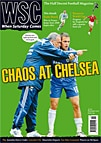 Walking to the ground is not only a traditional part of the matchday experience, it’s good for you, too. Strangely, it’s becoming much more difficult to achieve. Pete Green reports
Walking to the ground is not only a traditional part of the matchday experience, it’s good for you, too. Strangely, it’s becoming much more difficult to achieve. Pete Green reports
“The pedestrian remains the largest single obstacle to free traffic movement,” said a Los Angeles planning report in the 1960s. Four decades and billions of tonnes of carbon emissions later, some UK planners are seeing the light and pedestrian access figures increasingly in new developments. Except for football stadiums, that is – where careless designs and cheap locations threaten to make walking to the match a thing of the past.
The planners of Shrewsbury’s New Meadow aimed to discourage driving with an array of park-and-ride schemes – but at first glance the stadium seems purpose-built to deter pedestrians. Oteley Road, a key access route, is paved on only one side and when the ground opened for pre-season friendlies fans dodged and ducked around signs and under branches, lumbered up and down sloped grass verges, and spilled out into the road as traffic passed by. The local authority moved quickly to cut speed limits – and, when the Shrews filled 6,200 of their 10,000 seats at August’s Carling Cup tie with Fulham, officials decided to close the road altogether just before and after games.
Shropshire County Council’s traffic manager, Hugh Dannatt, admits officials were taken aback by the numbers who chose to walk. “There was a match with Man City when we became aware that there were a number of problems around the area,” he says. That was a friendly on August 1, ten days before the season began – so should these issues have been recognised sooner? “It’s easy to say things could have been done differently, but the decisions taken were the right ones at the time,” Dannatt insists. “It was difficult to work out the exact numbers who would walk. There was no way of knowing it would be that many.”
Rob Cann is a Shrews fan working for Living Streets, a charity devoted to building a “walkable society”, and is disappointed by the pedestrian-unfriendliness of his club’s new ground. “If you build a stadium to hold 10,000 people, restrict people’s ability to park there and then not expect that at least 5,000 are going to walk – especially as it’s not miles away from the town – then it’s not particularly well planned.” The council is now looking to provide extra pavements and safety measures – funding permitting – but as winter approaches fans remain concerned about Oteley Road’s lack of street lighting.
Shrewsbury’s is one of many new grounds where poor planning hits pedestrians – see also Reading, Coventry, Chester and others. The Reebok, infamously, is about seven miles from the site of Burnden Park. The explanation is nothing new – it’s all about money – but the economic “push factor” behind exurban stadiums is doubly potent. For one thing the land is cheaper than in the community locations the clubs are vacating; for another, the clubs enjoy a monopoly on refreshments. The food may be unhealthy and unpalatable; the beer may be over‑chilled and overpriced (and all over your legs when the plastic glass splits); but when you’re miles from civilisation it’s the official stadium bar or nothing. “At Reading we asked a copper where the nearest pub was,” says Forest fan Lee Tombs. “He pointed towards the dual carriageway and said, ‘It’s about an hour that way,’ and laughed.”
With the government concerned about health and obesity, approving stadiums we can’t walk to seems as perverse as the fitness fashion victim who drives four miles to spend an hour on a gym running machine. As Lucy Abell of Living Streets puts it: “There’s something particularly obtuse about sporting venues that actively discourage the use of active travel to get there.”
For many, then, the walk to the game is already lost – but for thousands more it remains integral to the precious ritual and rhythm of our matchdays. The walk is when we stretch out the starry canvas our hopes are daubed across and feel a flutter of excitement as the floodlights peep over the rooftops. The walk is as long-established an aspect of fandom as the match itself, and if we let it slip away our experience of football will continue to be diminished piece by piece.
Living Streets is preparing a campaign encouraging planners to consider pedestrians in future stadium developments and wants to hear the experiences and views of fans. To share yours, visit livingstreets.org.uk
From WSC 249 November 2007